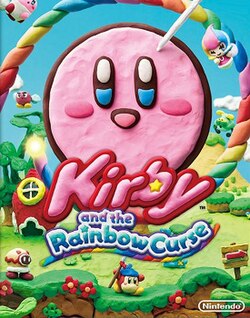Critical response
Kirby and the Rainbow Curse received mixed reviews. It received an aggregated score of 75% on GameRankings based on 50 reviews [15] and 73/100 on Metacritic based on 72 reviews. [16] Fellow review aggregator OpenCritic assessed that the game received fair approval, being recommended by 54% of critics. [17]
Japanese gaming magazine Famitsu awarded Kirby and the Rainbow Curse a 34 out of 40, with one reviewer stating "Although guiding a character by drawing lines with the GamePad isn't a new mechanism in itself, the game deserves applause for making it more interesting to play. The visuals are cute and look like clay animation. The game is filled with a surprisingly diverse load of gimmicks so it excites in many ways. The game is packed with the true charm of action games." [24]
Giant Bomb 's Dan Ryckert gave Kirby and the Rainbow Curse two stars out of five, comparing the title negatively to its DS predecessor. He felt that the levels were too simple and linear, and the collectibles were too easy to reach. He disliked that Kirby could not steal enemies' abilities like in Canvas Curse, and thought that the vehicles Kirby could turn into made certain levels "even more stripped-down." While he found the controls functional, the repetitive boss fights were frustrating due to the stylus' lack of precision. Ryckert preferred to play as a Waddle Dee, whose traditional control scheme afforded more reliable platforming and boss fighting than the "unreliable stylus paths" provided. However, Ryckert did find the clay-based art style "gorgeous." [31]
IGN 's Marty Sliva found the game much more enjoyable, awarding it 8.0 out of 10. He appreciated the game's occasional difficulty and its variety, finding the vehicular stages enjoyable and the various world themes beautiful. Sliva thought that the visuals were "absolutely gorgeous," praising details like fingerprints in the clay and the stop-motion movements of the bosses, but was disappointed that he had to focus on the GamePad instead of an HDTV. He found that Waddle Dee multiplayer did not "add a whole lot to the experience," but it was "a nice experiment to test out." [33]
Nintendo Life's Jon Walgren gave Rainbow Curse seven stars out of ten. He found the game "charming" and its visuals to be "the prettiest [...] on Wii U so far," but was disappointed that the clay aesthetic did not influence the gameplay like the fabric did in Kirby's Epic Yarn. He thought the main campaign was easy, but the Challenge Mode and the search for collectibles provided a bit more difficulty. Like other reviewers, Walgren would have liked to see the game in high definition but found he had to focus on the GamePad's low-definition screen. Playing with others was "pleasant," but it was not the best local multiplayer experience on Wii U. [34]
Hardcore Gamer's Dermot Creegan gave the game a 4.5 out of 5, calling it a "constantly creative adventure that offers players something they won't find anywhere else." He praised the claymation aesthetic calling it "astoundingly beautiful," while also complimenting the number of collectibles and challenges. [32]

